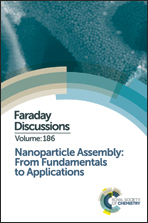Dynamics of dissipative self-assembly of particles interacting through oscillatory forces†
Abstract
Dissipative self-assembly is the formation of ordered structures far from equilibrium, which continuously uptake energy and dissipate it into the environment. Due to its dynamical nature, dissipative self-assembly can lead to new phenomena and possibilities of self-organization that are unavailable to equilibrium systems. Understanding the dynamics of dissipative self-assembly is required in order to direct the assembly to structures of interest. In the present work, Brownian dynamics simulations and analytical theory were used to study the dynamics of self-assembly of a mixture of particles coated with weak acids and bases under continuous oscillations of the pH. The pH of the system modulates the charge of the particles and, therefore, the interparticle forces oscillate in time. This system produces a variety of self-assembled structures, including colloidal molecules, fibers and different types of crystalline lattices. The most important conclusions of our study are: (i) in the limit of fast oscillations, the whole dynamics (and not only those at the non-equilibrium steady state) of a system of particles interacting through time-oscillating interparticle forces can be described by an effective potential that is the time average of the time-dependent potential over one oscillation period; (ii) the oscillation period is critical to determine the order of the system. In some cases the order is favored by very fast oscillations while in others small oscillation frequencies increase the order. In the latter case, it is shown that slow oscillations remove kinetic traps and, thus, allow the system to evolve towards the most stable non-equilibrium steady state.
- This article is part of the themed collection: Nanoparticle Assembly: From Fundamentals to Applications

 Please wait while we load your content...
Please wait while we load your content...